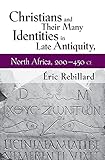Christians and their many identities in late antiquity, North Africa, 200-450 CE /Éric Rebillard.
Material type: TextPublication details: Ithaca : Cornell University Press, (c)2012.Description: 1 online resource (vii, 134 pages)Content type:
TextPublication details: Ithaca : Cornell University Press, (c)2012.Description: 1 online resource (vii, 134 pages)Content type: - text
- computer
- online resource
- 9780801465994
- BR190 .C475 2012
- COPYRIGHT NOT covered - Click this link to request copyright permission: https://lib.ciu.edu/copyright-request-form
| Item type | Current library | Collection | Call number | URL | Status | Date due | Barcode | |
|---|---|---|---|---|---|---|---|---|
 Online Book (LOGIN USING YOUR MY CIU LOGIN AND PASSWORD)
Online Book (LOGIN USING YOUR MY CIU LOGIN AND PASSWORD)
|
G. Allen Fleece Library ONLINE | Non-fiction | BR190 (Browse shelf(Opens below)) | Link to resource | Available | ocn961556292 |
Includes bibliographies and index.
Setting the stage : Carthage at the end of the second century -- Persecution and the limits of religious allegiance -- Being Christian in the age of Augustine.
"For too long, the study of religious life in Late Antiquity has relied on the premise that Jews, pagans, and Christians were largely discrete groups divided by clear markers of belief, ritual, and social practice. More recently, however, a growing body of scholarship is revealing the degree to which identities in the late Roman world were fluid, blurred by ethnic, social, and gender differences. Christianness, for example, was only one of a plurality of identities available to Christians in this period. In Christians and Their Many Identities in Late Antiquity, North Africa, 200-450 CE, Éric Rebillard explores how Christians in North Africa between the age of Tertullian and the age of Augustine were selective in identifying as Christian, giving salience to their religious identity only intermittently. By shifting the focus from groups to individuals, Rebillard more broadly questions the existence of bounded, stable, and homogeneous groups based on Christianness. In emphasizing that the intermittency of Christianness is structurally consistent in the everyday life of Christians from the end of the second to the middle of the fifth century, this book opens a whole range of new questions for the understanding of a crucial period in the history of Christianity"--Publisher's Web site.
COPYRIGHT NOT covered - Click this link to request copyright permission:
There are no comments on this title.
